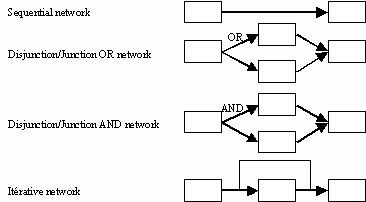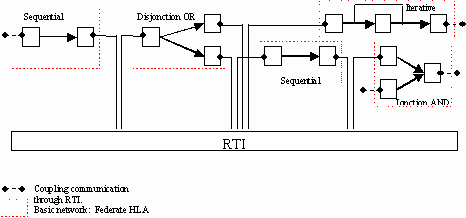
Figure 1 Types of tasks basic network
G. Zacharewicz, C. Frydman, C. Zanni
LSIS, UMR-CNRS 6168, Marseille, France
The purpose of this work is to study the integration of workflow simulation in HLA (High Level Architecture). For this purpose, models of basic networks for workflows were defined. These networks identify the various types of tasks chaining in a stream of processes, such as the sequential chaining, logic AND disjunction/connection, logic OR disjunction/connection and iterations, as presented in the figure 1.

Figure 1 Types of tasks basic network
From this postulate, the elements have been translated into their equivalent Petri nets due to its operational semantics that is easily simulable. After establishing a class hierarchy through an object representation of these elements, they have been implemented in C++ because the simulator we use is C++ based. These C++ simulable models and the corresponding object representation will allow the integration of these data into an HLA framework if they are HLA compliant. For this goal, we establish that classes are the different kinds of tasks chaining ; and interactions identify the coupling of the models. We’ve designed an OMT that will be integrated in the HLA Fed file. The C++ code we got has to be completed with the class RTI:FederateAmbassador.

Figure 2 Example of basic tasks networks chaining